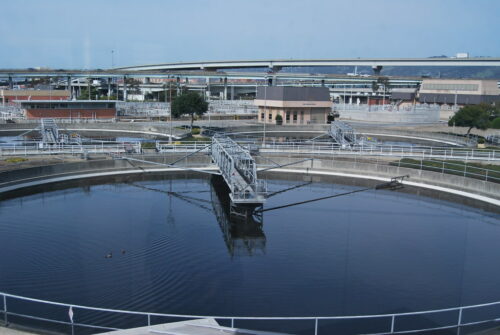Image courtesy of Flickr.
Wastewater is not something that most people in developed nations want to, or have to, think about. For most Americans, as soon as water goes down the drain, it is out of sight and out of mind. We view waste in our pipes in the same way we view the waste in our trash cans—as depleted resources to eject from our homes and businesses.
The current process of wastewater treatment focuses on cleaning water to reintroduce it into the environment. Through a complex series of physical, chemical, and biological processes, engineers degrade and remove contaminants from wastewater to make the resulting water as safe as possible. However, this process creates solid waste of its own, ranging from organic materials to plastics to metals. These are typically addressed via conventional means, such as landfill disposal.
Ryan DuChanois, a researcher at the Yale Department of Chemical and Environmental Engineering, sought to challenge the idea that wastewater contaminants are simply pollutants to separate and discard. “Currently, there is no method to turn waste from wastewater into something beneficial,” he said. This new strategy evokes the concept of a circular economy, where materials can restart the life cycle of manufacturing rather than being disposed of as waste by default.
Unfortunately, conventional wastewater treatment processes use membranes that cannot separate waste to the level of extracting valuable ions. Therefore, to achieve his vision of a circular economy, DuChanois and his team set out to develop membranes with inspiration from the material already capable of this level of specificity: our cells.
Biological ion channels are built to maintain the delicate flow of ions in and out of cells, overseeing the exchange of nutrients and minerals. In addition to being designed to a much smaller scale than any human-made materials can be, biological ion channels have an extra special characteristic: “Biological channels utilize the interactions between species of interest and the channel to obtain selectivity, and we don’t fully leverage that in the synthetic membranes we use today,” DuChanois said.
The team emulated the biological approach by constructing a film of polymers containing binding sites designed to interact with key ions favorably. They then layered the polymers on top of one another to create membranes of desired thicknesses. DuChanois tested the rate at which different ions in water could travel through the membranes, where the ratio between a desired ion, such as copper, and an unwanted ion, such as magnesium, indicated the level of specificity of the membrane. He discovered two surprising trends: first, conventional logic says that stronger binding interactions between an ion of interest and the membrane should cause it to get “stuck” in the membrane, thereby limiting its ability to flow through; on the contrary, DuChanois found that stronger binding interactions aided some ions in diffusing across the membrane, consequently increasing the membrane’s specificity. The relationship between membrane thickness and selectivity was similarly counter-intuitive. When copper ions of interest traveled through a membrane, the diffusion rate decreased as membranes of larger thickness were tested, while unwanted ions diffused at a rate independent of membrane thickness. As a result, the selectivity decreased for thicker membranes.
These two new properties provide an important tool for engineers, potentially enabling the selection of certain valuable ions in wastewater and recovery for their use in manufacturing. The two-pronged effect of minimizing the amount of waste produced and increasing the supply of materials is particularly beneficial for substances that are energy-intensive to obtain normally. An example is lithium, which is required for energy storage in green technology and electronics. According to DuChanois, targeting certain wastewater streams from industrial facilities and oil-drilling sites could allow for more efficient reclamation due to the elevated presence of ions used in manufacturing.
There are still notable obstacles to applying these membranes and the concept of resource reclamation from wastewater. For instance, thinner membranes that are more selective are also more susceptible to mechanical stability concerns, such as breaking under water flow pressure. DuChanois has also identified the need to assess various materials to determine which ions are the most critical and viable for recovery. Additionally, he hopes to integrate ion-selective membranes into a more scalable process for industry usage.
Modeling wastewater technology after the evolution-tested components of the human body has proven an effective method to foster innovation. Ion-selective membranes can join Velcro and aerodynamic trains as everyday necessities inspired by nature.

